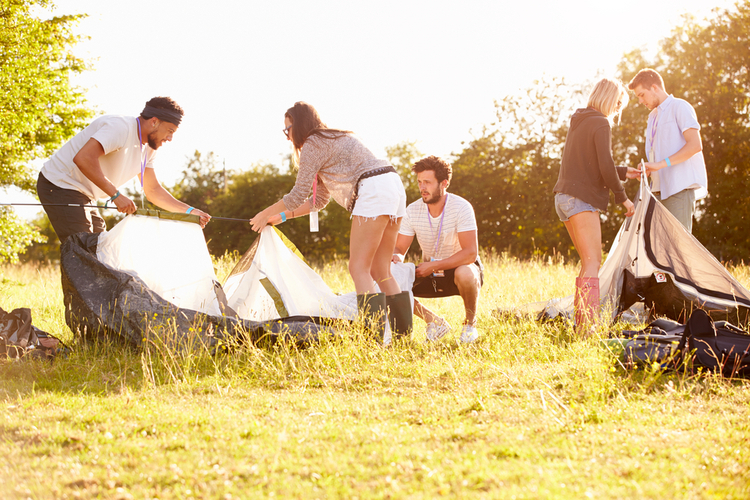
If there’s one thing guaranteed to ruin your camping holiday, it’s a poorly pitched tent. Granted, it’s not ideal if it throws it down with rain the whole time, but at least if your tent is put up properly you have somewhere dry to take shelter.
However, If you don’t properly erect your tent, then you’re setting yourself up for a fall from the outset. We want you to have the best possible holiday, so here are some top tips on how to pitch a tent that will at least set you off on the right foot.
Winfields Outdoors has made this guide to help you pitch a tent like a pro, whether you're a seasoned camper or a rookie. We'll take you through the important steps, from before you leave to on-site advice.
Read on about how to put up your tent quick and easily with Winfields Outdoors...
Before you pitch your tent
There are a few bits and pieces you should do before you actually put up your tent...
Check your tent before you go camping
Before you even get anywhere near the campsite, make sure you check your tent and that everything is as it should be. You don’t want to try and put it up only to realise there’s a nasty tear in there. You should also double-check new tents, just to be on the safe side.
Read more: The Ultimate Guide to Tent Repair and Maintenance
Put your tent up in your back garden or even a nearby field just so it’s all in order and you know what you’re doing.
Here’s why checking your tent before you go camping is so important.
Read the instructions
So many people completely ignore instructions when putting up a tent and it often leads to disaster. The instructions aren’t in there for fun, so even if you’ve put up a thousand tents before, it’s always worth reacquainting yourself with the instructions just so you definitely know what you’re doing.
You might want to impress your fellow campers with how quickly and smoothly you put up your tent, but you’ll look a bit daft when you realise the whole thing is put together incorrectly.
Don’t do it alone
Unless you’re on a solo camping trip, get someone to help you put your tent up. This is particularly important if you have a large tent, as trying to do it all by yourself will either take you a considerable amount of time or, more likely, end in abject failure.
Even for two-man tents, if there’s someone else there to give you a hand, accept their help and you’ll be kicking back and relaxing much quicker.
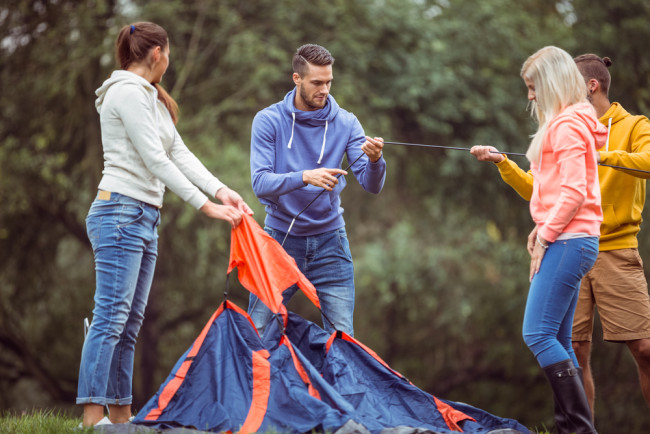
Where To Pitch Your Tent
You can’t just rock up to a field or campsite and pitch your tent any old place. Even if you’re given a specific pitch, there are still a few things to consider about where exactly to erect your tent, such as:
Find flat ground
If possible, always try and find flat ground on which to pitch your tent. It makes putting up your tent a lot easier and is just generally a lot more comfortable.
If you do have to pitch on a slope, position the tent so the door is facing downhill and/or in the same direction as the prevailing wind. This makes it less likely for rain to get in or for sudden gusts of wind to get caught inside the tent.
Leave plenty of room around you
Always try and leave a good amount of space around your tent. Try to leave at least 5 metres between yourself and other tents. This gives plenty of room for guy lines, will reduce the risk of tents blowing into each other in high winds, and is also good for privacy’s sake.
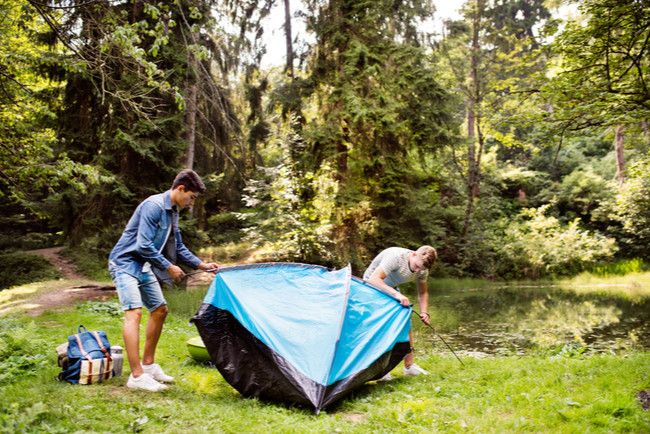
Read more: 12 UK Campsites You Must Visit
Also, make sure you pitch far away from campfire spots. The last thing you want is for your tent or equipment to catch fire.
Obviously, if you’re at a music festival, you might not have the luxury of space, but still do your best to leave as much room as possible around your tent.
Use bushes for shelter
It’s not so important to leave the same amount of room from bushes and hedges, although still ensure you have enough room for guy lines. You can use bushes and hedges to protect you from wind and rain. However…
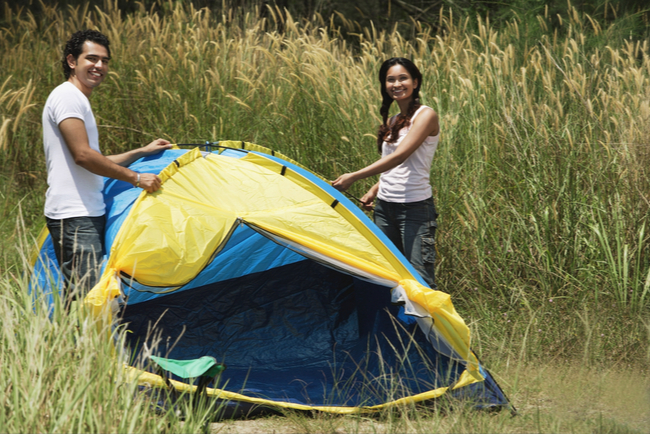
Don’t pitch under a tree
It might seem tempting to pitch your tent under a tree, but it’s not as good an idea as you think. Rainwater will drip very loudly onto your tent, but you have to be more worried about tree sap, as this will prove very tough to get off.
Also, any birds who have taken residence in the tree… well, we’re sure you know where we’re going with that one.
And it might sound dramatic, but should there be a thunderstorm, the last place you want to be is under a tree.
Avoid wet ground
Where possible, try and avoid wet and marshy ground. Not only will this make pitching the tent difficult, but will also increase the likelihood of water seeping into the tent. The bottom of hills are particularly troublesome as, obviously, any rain or groundwater will run down and collect there.
The ground close to streams or ditches may also be saturated, so choose your spot carefully.
Clear the area
Before you lay out your tent, make sure you clear the area and ensure it’s free from anything that could damage the tent in any way. This includes rocks, stones, sticks, and even tent pegs left behind by previous campers.
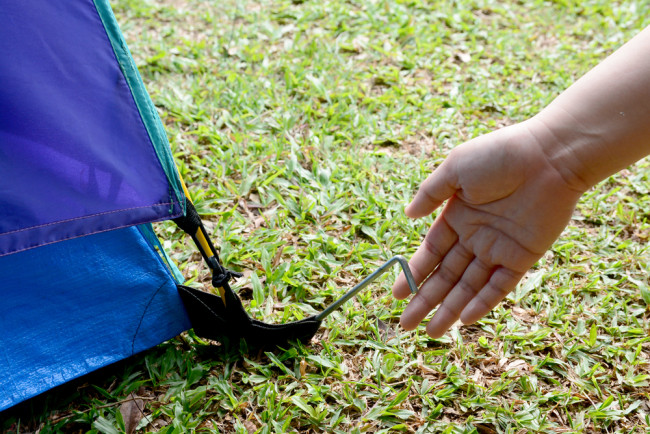
Pitching Your Tent
So you’ve found the perfect spot on flat, dry ground not too close to other tents. Now you actually have to put the thing up. Of course, follow the instructions as we mentioned, but here are a few key pointers you should bear in mind…
- Use a tent footprint - by pegging down a tent footprint first, you can position your tent exactly where you want it, as well as provide extra protection to your groundsheet.
- Peg down the groundsheet first - the rest of the pegging can be done later.
- Peg the back down first - by pegging down the back of the tent first, even before any poles are in, you can anchor the tent, preventing it blowing away in the wind. You can then go and re-peg once you're done.
- Don’t force the poles too much or they could break. If it feels like you are forcing them, double-check they aren’t snagging on anything.
- Don’t pull the poles through - push them. If your tent has poles connected by elastic, pulling them will serve only to separate them and make your job more difficult.
- Ensure all zips are closed when erecting the tent.
- Pegs should be hammered in using a mallet at a 45-degree angle with the hook pointing away from the tent. Don’t stand on them or you risk bending them.
- Guy lines should follow the seams of the tent where possible.
- Fully extend all pegging point straps - this will make putting the poles into the pins much easier and reduce the risk of snapping or bending the poles.
- For larger tents, once you've begged down the back and erected the poles, drag the tent forward and peg out the two front guy lines. This will help keep the tent in places so you can peg the rest of it down.
- Don’t pull everything so tight that it has no room to give in windy conditions.
Take a look at our full range of tent accessories or entire tents collection including:
Tents by Size | Family Tents | Polycotton Tents | Tents by Brand
Read more from the Winfields Blog to set you up for 2020...
⛰ 🏕 🌳
Don’t forget to take a look at our camping blog for more posts like these…
The Best UK Campsites To Stay At in 2020 | The 10 Best Family Camping Tents 2020 | Inflatable Tent & Air Tent Buying Guide









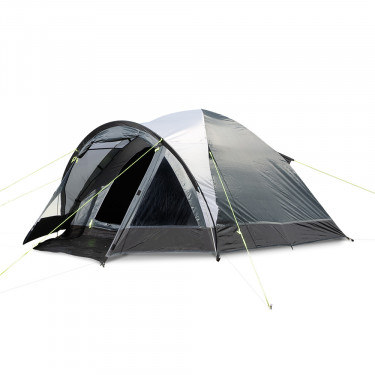


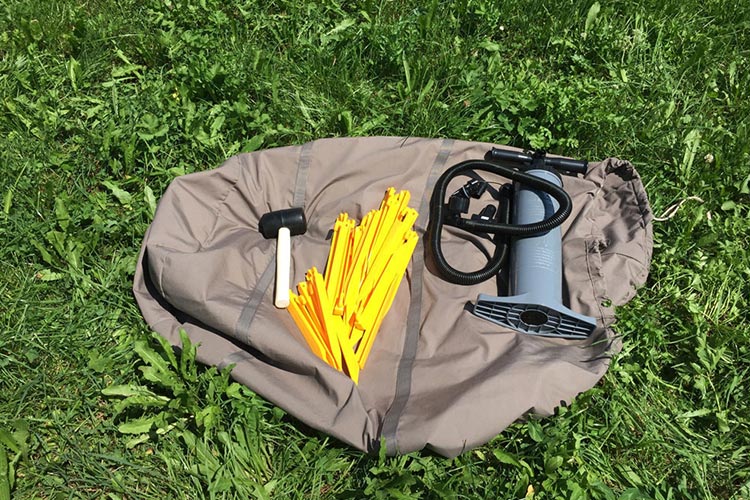


thanks for your comment and we're glad you want to take the plunge and have a go at camping. We'd recommend you take a look at our 5 & 6 person tents, which will give you the space you need without feeling cramped. You can see all those here: www.winfieldsoutdoors.co.uk/equipment/tents/5-6-person-tents/
When it comes to specific models, we'd recommend the Sunncamp Shadow 600 - www.winfieldsoutdoors.co.uk/sunncamp-shadow-600-exclusive-tent/. The layout of this tent is great for families, and it's on sale at the moment, making it fantastic value for money.
Other excellent tents you might want to consider are the Vango Orava 600XL, the Kampa Hayling 6, and the Kampa Watergate 6.
We hope that helps. If you have any other questions, please let us know.
Great to hear that you're looking to start camping - I'm sure you'll enjoy it!
This would all depend on your budget. I would advise you to give our customer care team a call and they can happily talk to you in further detail about this. Contact details for our customer care team can be found here.
One thing I would personally recommend, with you going to France, is potentially looking at a polycotton tent which you can read more about in our guide here.
I hope this helps.